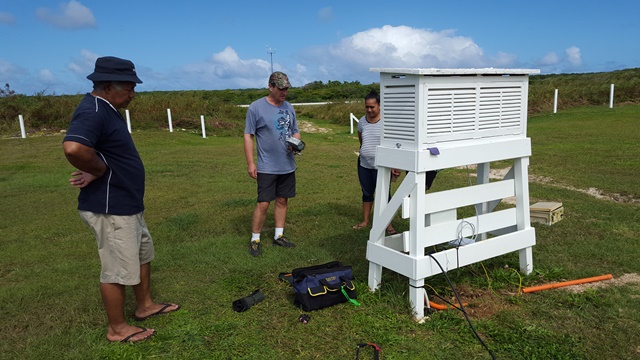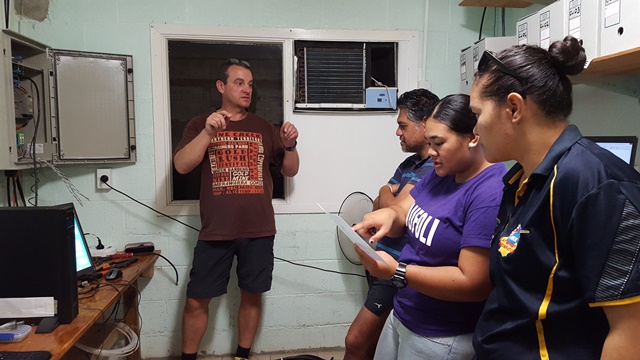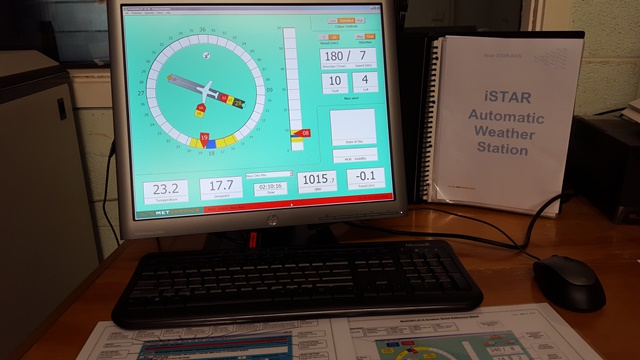
Climate Change Resilience
21 July 2016, Rarotonga Cook Islands - A new Automated Weather Station in Niue will assist with improving the safety standards of Niue's aviation and the quality of weather and climate data for development planning and early warning services in Niue.
Funded by the Finnish-Pacific (FINPAC) Project, the iSTAR Automated Weather Station is a new milestone achievement for the Pacific islands. FINPAC aims at reducing the vulnerability of the livelihoods of Pacific islanders to the impacts of climate change through strengthening the Meteorological Services.
"In supporting this activity we are also helping with the global efforts to improve the quality, timely, distribution, easy access to meteorological data," said Ms. Christina Leala-Gale the FINPAC Project Manager.
 Installing the sensor for the iSTARAWS, Photo: Niue Meteorological Service
Installing the sensor for the iSTARAWS, Photo: Niue Meteorological Service
"We're also grateful for the support from the World Meteorological Organization and the Finnish Meteorological Institute in facilitating this activity."
While the AWS will supply information that is required for national purposes, much of the data recorded by the iSTAR Automated Weather Station will also help fill gaps in information from the Pacific shared through the Regional Basic Synoptic Network (RBSN) – core global weather and climate observations system.
These help weather and climate forecast and prediction accuracy and understanding of current atmospheric conditions.
 The iSTARAWS was installed by the Meteorological Service of New Zealand Ltd. Photo: Niue Meteorological Service
The iSTARAWS was installed by the Meteorological Service of New Zealand Ltd. Photo: Niue Meteorological Service
There are very few Pacific island stations that are part of the RBSN which are not providing observation information, this in turn affects the early warning capacities of the National Meteorological Services as they do not have sufficient real-time information about the conditions in the areas affected.
"This can now provide us with a range of met observations, which we were limited by in the past to wind direction and speed as the observations were done manually, this can now measure wind directions, speed, pressure, relative humidity and so much more," said Ms. Melissa Talagi Douglas the Climatology Officer of the Niue Meteorological Service.
"We are now seeking support for two more components to be added to this AWS so we can measure cloud height and visibility – once we have those added this new system will be well rounded and able to observe everything required for a full observation."

The iSTAR Automated Weather Station was installed in the Niue Meteorological Service in June this year and is now in operation. The Meteorological Service of New Zealand Ltd was contracted to carry out the work.
"We'd like to thank the FINPAC Project and partners for their support in helping make this a reality."
FINPAC is a partnership between the Government of Finland, and the Secretariat of the Pacific Regional Environment Programme (SPREP) implemented in collaboration with the World Meteorological Organization (WMO) and the Finnish Meteorological Institute (FMI).
Funded by the Finnish-Pacific (FINPAC) Project, the iSTAR Automated Weather Station is a new milestone achievement for the Pacific islands. FINPAC aims at reducing the vulnerability of the livelihoods of Pacific islanders to the impacts of climate change through strengthening the Meteorological Services.
"In supporting this activity we are also helping with the global efforts to improve the quality, timely, distribution, easy access to meteorological data," said Ms. Christina Leala-Gale the FINPAC Project Manager.
 Installing the sensor for the iSTARAWS, Photo: Niue Meteorological Service
Installing the sensor for the iSTARAWS, Photo: Niue Meteorological Service"We're also grateful for the support from the World Meteorological Organization and the Finnish Meteorological Institute in facilitating this activity."
While the AWS will supply information that is required for national purposes, much of the data recorded by the iSTAR Automated Weather Station will also help fill gaps in information from the Pacific shared through the Regional Basic Synoptic Network (RBSN) – core global weather and climate observations system.
These help weather and climate forecast and prediction accuracy and understanding of current atmospheric conditions.
 The iSTARAWS was installed by the Meteorological Service of New Zealand Ltd. Photo: Niue Meteorological Service
The iSTARAWS was installed by the Meteorological Service of New Zealand Ltd. Photo: Niue Meteorological ServiceThere are very few Pacific island stations that are part of the RBSN which are not providing observation information, this in turn affects the early warning capacities of the National Meteorological Services as they do not have sufficient real-time information about the conditions in the areas affected.
"This can now provide us with a range of met observations, which we were limited by in the past to wind direction and speed as the observations were done manually, this can now measure wind directions, speed, pressure, relative humidity and so much more," said Ms. Melissa Talagi Douglas the Climatology Officer of the Niue Meteorological Service.
"We are now seeking support for two more components to be added to this AWS so we can measure cloud height and visibility – once we have those added this new system will be well rounded and able to observe everything required for a full observation."

The iSTAR Automated Weather Station. Photo: Niue Meteorological Service
The iSTAR Automated Weather Station was installed in the Niue Meteorological Service in June this year and is now in operation. The Meteorological Service of New Zealand Ltd was contracted to carry out the work.
"We'd like to thank the FINPAC Project and partners for their support in helping make this a reality."
FINPAC is a partnership between the Government of Finland, and the Secretariat of the Pacific Regional Environment Programme (SPREP) implemented in collaboration with the World Meteorological Organization (WMO) and the Finnish Meteorological Institute (FMI).